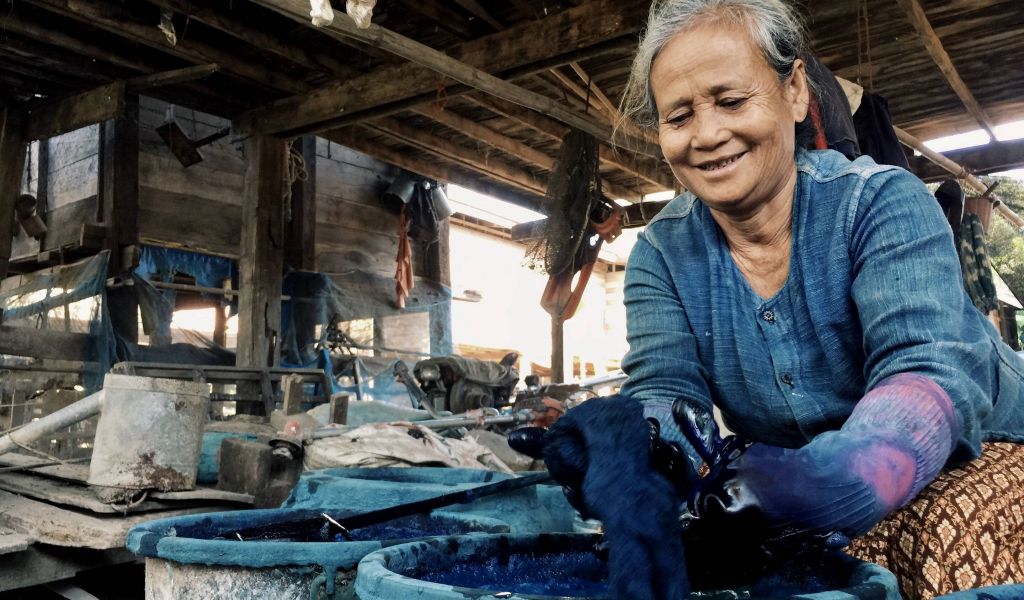From remote Laos to haute couture: A journey of indigo dye

Today, indigo is the most popular colour for denim worn by millions of people worldwide. Every year, tens of thousands of tonnes of indigo dye is produced but most of it is synthetic. Its natural version is harder to find as the extraction of colour is done by hand in a complicated and time-consuming process. As a result, natural indigo-dyed garments often come with a high price tag. A 140 x 140 cm Hermes silk scarf for instance – hand-rolled and dyed with natural indigo pigments – can cost US$1,950.
Yet, little is known about the origin of this dark blue dye, and even less so about the people who create it. In Laos, many of them live a simple life in a remote village of Lahanam, 500 kilometres southeast of the capital Vientiane. Here, more than 300 families spin countless cotton threads into beautiful dark blue fabric on a daily basis. All of them are hand-dyed with natural indigo substances harvested from the locals’ own gardens. A piece of 100 x 100 cm indigo-dyed cotton here costs less than US$2 – a world apart from its market value. The price may seem unreal for many fashion lovers. It does not for the villagers, who have spent months growing the plant, dying and weaving the cotton. In fact, income from natural indigo dye has transformed their lives over the past decade, ridding families of poverty and sending many children to school. “The business is doing so well we can’t produce fast enough,” said 60-year-old Sisavath Meevorachak. When they are not farming, both she and her husband make natural indigo dye for sale. Each month, the couple earns about US$1,000 from harvesting leaves of the local indigo plant and extracting the natural dark blue colour out of them.
Although Sisavath enjoys the extra income, the process of turning fresh indigo leaves into dark blue dye takes a lot of hard work. Once the seeds are sown, she has to wait for three months for the plants to grow. Old leaves are then handpicked in the morning when the sun is not so harsh. “We only pick leaves from the branches with pods on them,” said Sisavath’s husband Noy, pointing at several long brown pods hanging from one of the indigo plants in his garden across the Banghiang River. Each of them is full of tiny black seeds. “If we pick young leaves, you won’t get the beautiful shade of blue,” his wife added. Back at their house, the leaves are soaked in water for 24 hours. When the water turns green the next day, they are removed and a scrap of cloth is used to filter out impurities. More filtering is done to produce thick green paste. What happens next is a fascinating work of science in the form of local wisdom that has been passed on for generations. The thick paste is carefully mixed with a precise amount of quicklime, rice wine, crushed citrus leaves and ash water from burnt coconut trees. The fermentation takes a few days to produce the end product – natural deep blue dye. “We get US$3 per kilogramme for our indigo dye,” Noy said.
Like other villagers, Noy and Sisavath sell their natural indigo dye to local traders who then export it overseas. “Many foreign countries are interested in our products. It’s our special skill because it’s what we’ve been doing for generations. It’s also 100 per cent natural,” said village chief Somephone Photisane. “We’re so proud and happy to see Lao products making our name known overseas.” However, the growing success of Lahanam in producing and exporting high-quality indigo dye was not made possible by the local wisdom alone but also efforts from various parties to help rural communities in Savannakhet market their products. In 2008, the Lao government launched a programme called One District One Product (ODOP) with help from the Japan International Cooperation Agency. Focusing on Savannakhet and Saravanh provinces, ODOP is aimed at improving local livelihoods through the promotion of marketable products for export. “It has helped reducing poverty, improving the lives of the people in the village and creating jobs,” Somephone said. "We now have good roads, big houses, cars and electricity. Life is much more comfortable."
In a paddy field near his village, a few farmers are hard at work. All of them wear dark blue cotton shirts dyed with natural indigo from Lahanam. The material - durable and absorbent - is commonly used by rice farmers to protect their skin from the sun. But away in boutique shops overseas, the same material has been turned into various fashionable garments. Different fashion cut from the same cloth.
Information source: Channel News Asia.
